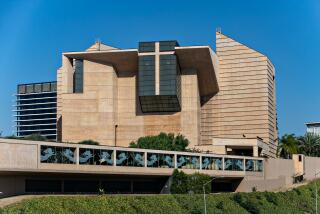Vatican Aware of Abuse for Centuries, Study Says
- Share via
Facing an estimated 800 sexual-abuse lawsuits in California, Roman Catholic officials have argued that the church learned only in recent years that it had a widespread problem with priests molesting children.
A report in February by the Archdiocese of Los Angeles, for example, said Cardinal Roger M. Mahony and other bishops didn’t realize until 1985 that sexual abuse by clergy was “more than a matter of tragic but isolated incidents.”
But a North Carolina priest and two former monks who live in Southern California say they have scoured ancient Vatican records and forgotten Latin texts to show just the opposite: that the church has recognized the problem of abuse by priests for at least 1,700 years and has failed to address it successfully.
“The contention that the present scandal is isolated to this era is completely debunked by the Roman Catholic Church’s own documents,” concluded Father Thomas P. Doyle and former monks Richard Sipe and Patrick Wall in their 375-page report, “Canonical History of Clerical Sexual Abuse.” The authors finished the report last month and are looking for a publisher.
Doyle, now a retired military chaplain, co-wrote a seminal report to U.S. bishops in 1985, warning of problems with abusive priests. Sipe counseled hundreds of abusive priests before he left the clergy. Wall, who heard molestation cases against priests when he served on the Archdiocese of St. Paul and Minneapolis tribunal council, now works for a plaintiff’s attorney.
Church defenders, pointing out that the three authors are allied with or paid by lawyers representing molestation plaintiffs, charge that the report is a ploy to strengthen their hand in court.
“Follow the money,” said Peter Michael Callahan, an attorney representing the Diocese of Orange. “What’s their motivation? They are professional witnesses who have a position to sell. It’s not exactly impartial scholarship.”
But the three men say the documents prove that the Catholic Church has known for centuries about molesters in its ranks and has no excuse for failing to take the danger to children seriously until scandal engulfed the church in 2002.
For example, in the 4th century, St. Basil of Caesarea set up a detailed system of punishment to deal with clerics at his monastery who molested boys. Perpetrators were to be flogged and put in chains for six months; they were never again allowed unsupervised interaction with minors.
In the 13th century, Pope Gregory IX added to church law a declaration that sexual abuse demanded expulsion from the priesthood and that perpetrators would be turned over to secular authorities.
“Canonical History” lists 58 high-level documents dealing with sexual misconduct of the clergy -- from books by saints to papal decrees to declarations by church councils -- as evidence.
One landmark document, published by Pope Benedict XIV in 1741, made it easier to punish priests who solicited sex during confession in exchange for absolution. The tone of the document showed “significant sensitivity to the spiritual damage done to solicited penitents,” the authors wrote.
And to ensure the latest church legislation was widely read, the pope ordered it posted on the doors of churches in Rome, including St. Peter’s, and at the city’s largest market.
Those rules became part of the canon law studied by 20th century priests and stayed in force until 1962, when Vatican officials opted for a more secretive process.
In that year, Pope John XXIII approved the publication of a procedure that instructed bishops to require those involved in the investigations, including the accuser and witnesses, to take vows of secrecy. Even the 1962 document itself was to be kept by bishops in their secret archives, and they were ordered not to discuss it.
Catholic scholars and others agree that sexual misconduct by priests has been an age-old concern. But they have doubts whether current Catholic bishops were conscious of the long history of sexual abuse within the church.
“Doyle and Sipe, whose work I know, are responsible and courageous men, but they are on a crusade,” said R. Scott Appleby, a history professor at Notre Dame University. Appleby said most bishops are neither historians nor theologians, and that “it is unreasonable to think they should be aware of the longer history of the problem.”
Beyond influencing the debate over church policy, the report could have an effect on massive litigation the church is facing in California by challenging a key 1987 appellate decision. Justices of the state’s 2nd District Court of Appeal ruled that “it would defy every notion of logic and fairness” to say that Catholic bishops should have foreseen the problem of sexual abuse by priests and that therefore the church cannot be held liable.
That case -- brought by a woman who said she was raped by seven Los Angeles priests as a teenager and impregnated -- has been cited by California Catholic dioceses in hundreds of legal motions involving sexual abuse lawsuits in attempts to relieve the church of liability.
Plaintiff attorneys say they hope to use evidence in the new report to overturn this decision. They used the argument for the first time this month during a three-day mock trial in Los Angeles staged by plaintiff attorneys to focus public attention on California molestation cases.
“It devastates the church’s argument that ‘We had no idea this was happening’ and that ‘No priest would ever do this,’ ” said Larry Drivon, a Stockton attorney who represents hundreds of alleged victims of clergy sexual abuse in California.
But church attorney Callahan, who represents the Diocese of Orange in nearly 100 cases now in mediation, said that most studies show the molestation rate within the Catholic clergy to be 3% to 5%.
Said Callahan: “Is that foreseeable or an aberration?”
More to Read
Sign up for Essential California
The most important California stories and recommendations in your inbox every morning.
You may occasionally receive promotional content from the Los Angeles Times.










